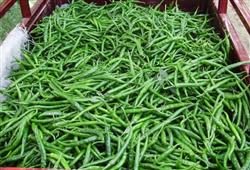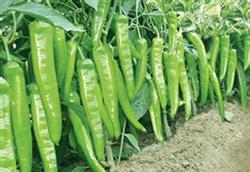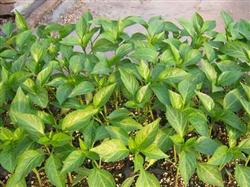High-yield cultivation measures of Hot Pepper in Spring

The essence of the selection of improved varieties in spring is early-maturing cultivation, and attention must be paid to the early maturity of varieties, high yield and disease resistance. Suitable varieties are red Yingda, Andalai, Holy Ark, in addition to Bulgarian sharp pepper, Sujiao No. 5 and so on. Soil preparation fertilizes 10,000 kg of high-quality manure or compost per mu, 25 kg of urea, 50 kg of diammonium phosphate and 100-200 kg of cake fertilizer per mu. These base fertilizers should be applied according to different planting methods. Chili peppers can be planted either in flat beds or in ridges. In order to facilitate plastic film mulching and watering, as well as to improve the ground temperature, it is recommended to use north-south ridge planting. When the ridge spacing is determined by ridge planting, the row-plant spacing must be determined according to the plant opening angle of the variety used. In winter and spring, it is suitable to adopt the method of close planting of two plants in one hole of large and small rows. Large line spacing 55-60 cm, small line spacing 40-50 cm. When fertilizing, first spread the organic fertilizer on the ground, turn it deep twice, so that the fertilizer and soil are fully mixed, then open the ditch according to the row spacing, apply cake fertilizer and chemical fertilizer in the ditch, and fully mix with the soil, then ridge on the ditch with a height of 15-20 cm. The scientific planting time is late January, and sunny days must be selected for planting, and it is expected that several consecutive sunny days will be encountered after planting. In this way, we should listen more and watch the weather forecast more. Planting should be carried out in the morning. When planting, the acupoints were opened according to the distance between the acupoints about 33 cm. Planting about 4000 holes per mu, 2 plants per hole, or 8000 plants per mu, to strive for early yield by close planting. The two plants in the same hole should be of the same size. When planting seedlings, warm water (30-40 ℃) was poured into the hole to release the seedlings, and the hole was sealed after the water seeped down. The pepper seeds should be soaked in 10% trisodium phosphate solution for 30 minutes before sowing. In order to prevent anthracnose and bacterial spot disease, it can be pre-soaked in water for 5-6 hours, then soaked in copper sulfate solution for 5 minutes, and then washed with clean water before budding. In order to cultivate strong seedlings, it is best to use electric hotlines to raise seedlings. When the seedlings grow out of 2 true leaves, divide the seedlings once, transplant the seedlings in a nutrition bowl, one plant per bowl, and put them on the electric hotline seedling bed. During the seedling stage, the daytime temperature remained at 28-25 ℃. Management after planting 1. In order to promote seedling retardation after planting, it is necessary to maintain a high temperature and humidity environment during the day and cover grass grass early in the day to keep a higher temperature at night. After seedling retardation, the temperature during the day is maintained at 26-28 ℃, and in the afternoon, when the temperature drops to 17-18 ℃, the temperature will rise by 2-3 ℃, and then the temperature will gradually decrease. The temperature should be about 15 ℃ when it is revealed the next day. After entering spring, the temperature rises gradually, we should pay attention to increase the ventilation rate, cover the grass at night properly, when the temperature of the uncovered grass is not lower than 15 ℃, we can not cover the grass at night, but the grass can not be removed until the middle of April to prevent the occurrence of disastrous weather such as late spring cold. 2. Light management the light intensity is low in winter. Under the condition of ensuring the temperature of the greenhouse, we should prolong the light time as far as possible, uncover the grass in the morning and cover the grass in the evening, make the plant see more light, keep the surface of the film clean and improve the light transmittance. A reflective screen can be hung on the north side of the greenhouse to improve the light intensity. In cloudy or snowy days, the light intensity is low and the respiratory consumption of the plant is high, so it can be fertilized outside the root and sprayed with 1% sugar water. 3. Under the condition of planting water and watering enough, the first fruit (door pepper) is generally not watered until the first fruit (door pepper) is seated. In the squatting seedling stage after seedling retardation, the soil under plastic film can keep moist and well ventilated. Squatting seedlings at the end of a water, when the door pepper has grown to about 3 cm in diameter, per mu with the application of ammonium sulfate 20 kg, potassium sulfate 10 kg. After that, each water or two water can be fertilized once with the water, and 10 kg of urea or 10 kg of ammonium sulfate can be applied per mu. Carbon dioxide fertilization should also be carried out. 4. Pruning should be carried out when the plant is adjusted to promote fruit. The method is that when the young fruit on the secondary lateral branch of the main lateral branch grows to 1 cm in diameter, the heart is removed after leaving 5 leaves on the upper part of the main lateral branch, so that the nutrition is concentrated to supply the fruit growth, and the overgrown branches that appear in the middle and later stage should be removed in time. 5. The main diseases of pepper are powdery mildew, anthracnose, soft rot, scab, virus and so on. The main insect pests are aphids and whitefly, which should be controlled as soon as possible. After timely harvest and planting, generally 40-50 days after harvest, door pepper, pepper should be picked early, so as not to affect the growth of the plant. In order not to damage the young branches during harvest, it is best to cut the fruit.
- Prev

Spring stubble chili peppers are straight and straight and do well at four points.
"the bending of chili fruit has a great influence on the price. Therefore, how to make chili peppers without bending fruit has become an important content for vegetable farmers to improve their income. Through the management of chili peppers over the past few years, I think that as long as we grasp the four points, chili peppers generally will not produce curved fruit. " Master Gong told the reporter. So, which four points did Master Gong say? First.
- Next

Techniques for raising seedlings of Spring sowing Pepper
(1) the sunny beds are going to choose plots where the land is fertile, leeward and sunny, and there are no eggplant or tomatoes planted in the previous crop to build sunny beds. For every mu of planting, seedlings should be raised according to 150 grams of seeds, and the sunny border should be more than 10 square meters. Apply sufficient base fertilizer, make soil moisture by flood, and use a small amount of urea, phosphate fertilizer and active potash fertilizer. Because of the sunny border.
Related
- Where is it suitable to grow horseradish in China? it is expected to see the middle altitude horseradish in Alishan.
- How to prevent tomato virus disease reasonably? (Control methods included)
- Many people like to plant towel gourd on the balcony. What are the main points of this method and management?
- What crops can chili peppers be mixed with?
- Fertilization techniques and matters needing attention in Tomato
- What are the grafting techniques for peach seedlings in spring?
- Harm and control methods of root swelling disease of Chinese cabbage
- What are the pests of sweet potatoes? How to prevent and cure it?
- Symptoms, causes and Control methods of navel Rot in Tomato
- The cause of "Cucumber rotten bibcock" in Farmers' planting Cucumber and its Control Plan

